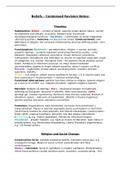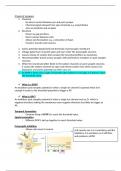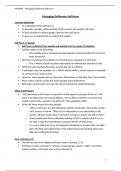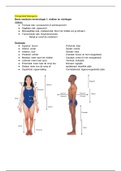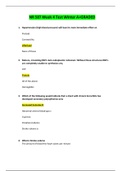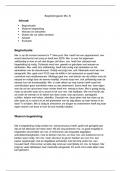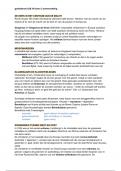Beliefs – Condensed Revision Notes:
Theories:
Substantive: Weber – content of belief, superior power above nature, cannot
be explained scientifically. Exclusive, Western bias. Functional;
social/psychological functions – Durkheim – contribution to social integration,
ultimate questions. Inclusive; no bias but too broad. Constructionist; own
definitions of religion, not universal, influenced by who has defining power, can’t
generalise.
Functionalism: Durkheim – sacred/profane, religion = sacred, provoke
powerful feelings – symbols represent great power/worship society – unite
believers. Represent collective conscience, rituals reinforce conscience,
reintegrates, strengthens and motivates us. Source of cognitive capacities, origin
of categories, e.g. creator. Aboriginal tribe – kin perform rituals worship sacred
totem. Evidence on totemism unsound, no sharp division between
sacred/profane, applies to single religion societies, doesn’t explain conflicts.
Parsons – legitimates central values, sacralising them, answers ultimate
questions, stability.
Bellah – civil religion, attach sacred qualities to society. U.S is loyal to state and
God, expressed in rituals/symbols = national anthem/flag.
Functional alternatives: perform functions similar to religion. Ignores religion
as a source of conflict, e.g. religious pluralism, neglects negative aspects.
Marxism: Religion as ideology, Marx – ideological weapon to legitimate
suffering as God given, favoured in afterlife, false consciousness. Lenin –
spiritual gin, creates mystical fog, dominant class divinely ordained. Product of
alienation; opium – dulls pain of exploitation, afterlife is illusory happiness.
Ignores positive functions, alienation unscientific.
Feminism: Organisations male dominated, exclusion from priesthood =
marginalisation. Places or worship segregate sexes, participation is restricted.
Sacred texts foretold by male prophets, anti-female stereotypes. Laws/customs –
fewer rights, unequal treatment, domestic role. Not always subordinate
(Armstrong), e.g. mother goddesses. Patriarchy influenced religion,
Woodhead – greater freedom, e.g. hijab as means of liberation. Gain status in
private sphere, e.g. Pentecostal empowering. Liberal Protestant organisations,
e.g. 1/5 female priests.
Religion and Social Change:
Conservative force: Upholds traditional beliefs, maintains status quo, e.g.
arranged marriage. Means of social control, subordination and false
consciousness.
Weber – Calvinism: Spirit of capitalism in modern capitalism. Predestination,
divine transcendence caused salvation panic, ascetism, vocation/calling – this
, worldly, wealth and success perform psychological functions to cope with panic,
reinvest wealth in business.
Hinduism/Confucianism: Hindu = ascetic and other-worldly. Confucianism =
this-worldly but not ascetic, material and economic factors necessary.
Overestimate role of ideas. Technological change birthed capitalism. Not
developed in all Calvinist countries.
Religion and Social Protest:
Civil Rights Movement: Bruce – black clergy gave support, churches provided
meeting places, meetings gave source of unity. Shamed whites by appealing
shared Christian values, ideological resource. Taking moral high ground, channel
dissent, honest broker.
New Christian Right: Traditional family/gender roles, televangelism to recruit.
Difficult to cooperate with others, lacked support, failed because of American
values.
Marxism: Bloch – principle of hope, contains images of utopia; promise rewards
but see what needs to be changed.
Liberation Theology: Catholic Church in Latin America; commitment to poor,
oppose military dictatorship. Priests helped poor establish base communities,
protection of church, mobile support. Pope condemned in 1980s so lost
influence.
Pentecostal Challenge: Option of poor, pull self out of poverty, led by church
pastors.
Millenarian Movements: Christ comes before Day of Judgement, transform
world by supernatural means.
Gramsci – hegemony, counter-hegemony, challenge and support r/c via an
organic intellectual.
Secularisation:
In Britain, there has been a decline in the no. of people going to church and an
increase in the age of churchgoers. Fewer baptisms/church weddings and a
greater diversity and choice. Attendance: 5% attend on Sundays, church
weddings halved, more bogus baptisms. Religious affiliation; Christian identities
fell by 1/3, no religion rising, Institutions – state taken over functions, aging
workforce and clergy.
Weber – Rationalisation: Rational thinking > religious medieval Catholic
worldview = God active in present world, humans influence forces by magical
means to ensure protection. Protestantism – God is transcendent, use
reason/science to discover laws of nature and control through technology.
Structural Differentiation: Parsons – process of specialisation that occurs
with development of industrial society, separate instits develop, disengagement
– functions transferred to other instits and become disconnected from wider
society. Privatisations; beliefs personal choice so lost influence.
Social/Cultural Diversity: Decline of community, religion lost hold.
Industrialisation; undermine consensus of religious beliefs that hold rural
communities together. Diversity – cannot avoid different views, plausibility of
belief undermined by individualism.

